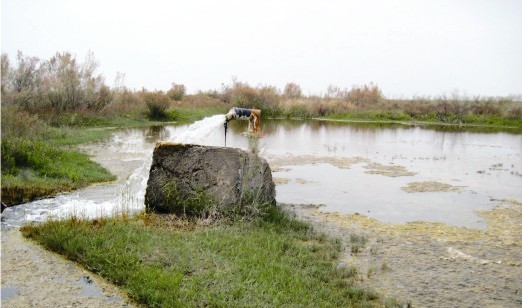About the project

“Artesian water based agriculture in Central Kyzylkum” project is supplemental project and logical continuation of PEER research project AID-OAA-A-11-00012 “Utilization of low quality water for halophytic forage and renewable energy production”.
It is aimed to inform about good results of the project related to cultivation of salt tolerant and halophytic plants using marginal water and land resources; to spread these information and raise awareness/competence among general public and policymakers; to give opened access to knowledge on saline water agriculture.
In 2012, the International Center for Biosaline Agriculture (ICBA) initiated the “Utilization of low quality water for halophytic forage and renewable energy production” project in Uzbekistan in collaboration with academic and research institutions as well as NGOs. The project was founded on the principle that using appropriate halophytic production systems in saline croplands would provide increased biomass, and thus enhance food security.
The abovementioned PEER project was aimed to assess the potential for halophytic plants as an economic resource via food for humans, animal feed, bioenergy production, or through maintaining or restoring agricultural production of conventional crops on high saline soils.
Specific objectives included:
(1) characterize halophytic growth, yield and salt uptake rates;
(2) identify halophytic nutritional value potential;
(3) examine impacts of halophytic crops on soil and water quality;
(4) model halophytic crop production and salt movements;
(5) assess the economic feasibility of halophytic crops for food security;
(6) conduct cost-benefit analysis to determine farmers’ perceptions of planting halophytic crops and assess their willingness;
(7) study biogas potential of various halophytes (read more ).
Activities and Outcomes
Two field research/demonstration sites were established, one in Central Kyzylkum (demonstrating natural inland salinity), the other in Khoresm (exhibiting secondary salinization of old irrigated agricultural lands near Shurkul Koshkupur Lake) in Uzbekistan. Field and laboratory analysis of water and soil chemistry were monitored… (read more)
Soil samples from the demonstration sites were analyzed to determine the type and extent of salinity and soil fertility, followed by field experiments to study the performance of salt-tolerant crops on marginal lands, and develop appropriate technology packages for cultivation of select halophytes. Four types of halophytes were intercropped with salt-tolerant crops such as sorghum, pearl millet, artichoke and licorice resulting in increased productivity on the demonstration farms by 2.5 times more than the degraded overgrazed pastoral lands… (read more)
After assessing the biomass of more than 60 halophyte species, 20 were found to be rich in protein, lipid, and hydrocarbon contents with forage potential for livestock feeding systems. In particular, Atriplex was recommended for improving and/or creating long-term autumn-winter pastures as it can improve range restoration of salty/loamy sand and alkaline soil. Root material of some halophytes was found to have high market demand by the industrial sector, such as licorice… (read more)
The biomass of few wild halophyte species was assessed for biogas production resulting in the identification of Karelina caspica which was never previously cultivated as it is inedible with poor forage value. ICBA experiments showed that it has high biogas production per unit of dry biomass making it an excellent bio-fuel source… (read more (1) and (2))
Additionally, the project augmented the United States Department of Agriculture (USDA’s) APEX field-scale model with a salinity module that can model salt ion dynamics in saline environments, including plant uptake and removal of salt from soil. Measured data was collected from the demonstration sites to assess model performance, followed by model improvements to enable the modeling of individual salt ions - as plants may experience toxic effects of different ions. (read more)
Manual on seed morphology and biology of seed germination of halophytes in Central Asia was developed. This is the first desk monograph on halophytes of Uzbekistan flora, containing data and information on more than 78 halophyte species along with illustrations. (read more)
